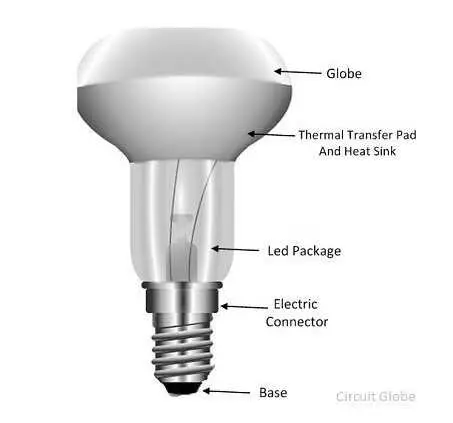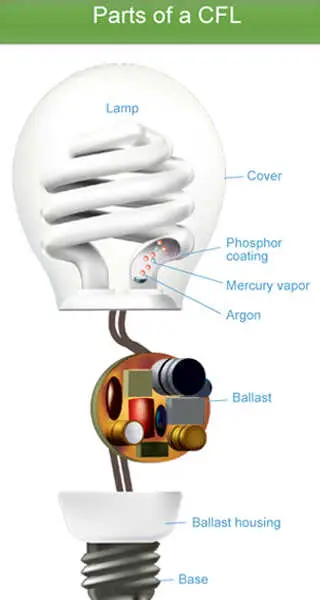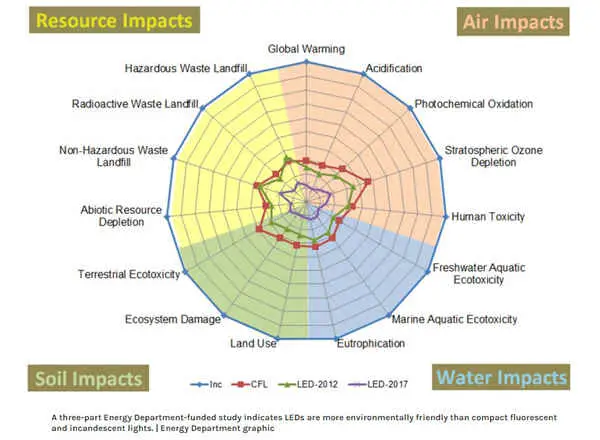LED vs CFL Bulbs: Energy Efficiency & Sustainability Comparison
As an Amazon Associate, Ecotero earns from qualifying purchases.
LED and CFL bulbs are two of the most energy efficient lighting solutions available today.
And over the years, there have been many discussions on which between the two is better.
So, we did the research for you.
Below is a comprehensive LED vs CFL bulb comparison that will guide you to choose the most energy efficient light bulb for every room of your home, office, and facilities.
Our hope is that with this information, you will be able to save as much electricity and get the most appropriate light bulb for any indoor and outdoor fixtures.
Let’s get started.
What is the Difference between LED bulbs and CFL bulbs?
LED Light Bulbs

A LED or light-emitting diode bulb is a “solid-state lighting” technology that emits light from a piece of solid matter or semiconductor.
Here’s how LED light bulbs work:
Electric current passes through a semiconductor (in this case, the diode) and the movement of electrons in the semiconductor produces light.
Meanwhile, traditional incandescent light bulbs work as electricity passes in a small wire or a filament.
The electricity heats the filament due to electrical resistance, and the heat “creates” the light.
The downside of this lighting technique is that so much energy is “wasted” to warm the filament before light is created.
This makes LED light bulbs up to 90% more energy efficient compared to traditional incandescent light bulbs.
CFL Light Bulbs

Compact fluorescent lamp (CFL) bulbs produce light differently than incandescent bulbs and LEDs.
As we just discussed, LED bulbs generate light by passing electricity through a semiconductor, and incandescent bulbs produce light by heating a wire filament.
However, CFL light bulbs work by passing electric current through a fluorescent tube that contains argon gas and a small amount of mercury vapor, generating ultraviolet light that excites a fluorescent coating (called phosphor), which then emits visible light.
And while CFL bulbs need a little more energy when they are first turned on, they can save up to 70% energy than incandescent bulbs.
LED vs CFL Bulbs General Comparison
Now that we’ve discussed the basic difference between CFL vs LED lights, let’s find out which of these two energy efficient light bulbs is better for you and the environment.
Here’s a quick peek of the results, but we urge you to read further for complete details.
| Categories | LED Bulb | CFL Bulb |
|---|---|---|
| Power Consumption (60W Incandescent Replacement) | 6-8 watts | 13-15 watts |
| Average Electric Cost for 25,000 Hours (At $0.15 per kWh) | $30 | $52 |
| Brightness | Similar | Similar |
| Heating Issues | Minimal | About 80% of energy releases as heat |
| Lifetime | 25,000 to 50,000 hours | 8,000 to 15,000 hours |
| Overall Energy Efficiency | More energy efficient than CFL | More energy efficient than Incandescent; less energy efficient than LED |
| Health Risks | Contains various heavy metals | Contains Mercury |
| Overall Environmental Impacts | More environmentally friendly than CFL | More environmentally friendly than incandescent lights; less than LED |
| Power Source Flexibility | Solar panels compatible | Solar panels compatible |
1. LED vs CFL Power Consumption
So the first question many consumers need answered is which consumes more electricity, CFL or LED?
While both undeniably consume less power than traditional incandescent bulbs, CFL bulbs consume more power than LEDs per unit of light produced.
This is because the lighting technology behind LEDs requires much less wattage than CFL when creating the same amount of light.
For instance, according to Diffen, LED bulbs that are equivalent to 60 watts incandescent bulbs only use 6-8 watts of electricity while CFL counterparts use 13-15 watts.
2. LED vs CFL Average Electric Cost for 25,000 Hours
If we compare the LED vs CFL bulb yearly cost, LED bulbs come out to be the more economical options.
According to Viribright, a 25,000 hour usage of LED light bulb on average will only cost you $30 at $0.15 per kWh, while it will cost you $52 using a CFL counterpart.
Meanwhile, 20SomethingFinance estimates that at $0.12 kWh electricity cost on 6 hours per day of use:
- LEDs would give you $167.53 in total savings over its lifespan compared to traditional incandescent
- LED bulbs would give you $16.53 in total savings over its lifespan versus CFL
3. LED Vs CFL Brightness
Another thing many consumers ask is are LED lights brighter than CFL bulbs?
Well, when comparing the brightness of different light bulbs, we need to talk about lumens.
HomElectrical explained that lumens is the measurement of how bright a light bulb is, no matter the type of bulb and wattage.
The more lumens the bulb has, the brighter the light it gives.
LED and CFL lighting technologies do not have a difference in brightness intrinsically.
However, while both bulbs have the same brightness, it doesn’t mean that they consume the same amount of energy to generate that level of brightness.
A table from Viribright showing how many watts of power incandescent, CFLs, and LEDs are required to produce that level of brightness.

As you can see, LEDs require much less energy to achieve a certain level of lumens.
Now, you might also be wondering:
Which light bulb is better for eyes, CFL or LED?
According to Ultralase, an eye expert blog, LED lights are less damaging to your overall eye health.
However, this is provided you pick warmer color lights as there is significantly less blue light and no UV rays produced at all.
We would also like to mention that another advantage of CFL vs LED for eyes is that LED bulbs do not take much time to start.
After you hit the switch, they glow instantly while CFL bulbs do not glow instantly as they take some time to warm up.
Speaking of warming up…
4. LED vs CFL Heating Issues
According to Energy.gov, LED bulbs emit very little heat when used.
In contrast, incandescent bulbs release about 90% of their energy as heat and CFLs release about 80% of their energy as heat.
5. LED vs CFL Lifetime
LED light bulbs typically last much longer than other lighting types, including CFL.
In comparison, newer LEDs have an average lifetime of 25,000 to 50,000 hours while CFLs have around 8,000 to 15,000 hours.
According to Energy.gov, a good quality LED bulb can last 3 to 5 times longer than a CFL.
6. LED vs CFL Overall Energy Efficiency
As you can guess, LED is the more energy efficient light bulb compared to CFL.
For starters, LEDs require less energy when achieving the same brightness as CFL and the majority of senergy LEDs used are used to create light rather than emit heat.
7. LED vs CFL Health Risks
One of the main health concerns of using CFL is it contains mercury.
The mercury content can evaporate and cause air and water pollution, and can have a harmful effect on humans, especially infants.
On the other hand, a study in 2010 revealed that some LEDs contain heavy metals like lead, nickel, and arsenic.

So before buying LED or CFL, make sure to read the label to be informed what toxic materials might be present in the light bulb.
You can also contact the manufacturer and ask them about potential health hazardous materials present in their product.
8. LED vs CFL Bulbs Overall Environmental Impacts
So LED vs CFL bulbs, which is more eco-friendly?
An Energy Department-funded study indicates LEDs are more environmentally friendly than CFL and incandescent lights.

LEDs use less energy than CFLs.
Moreover, because of the longevity of LED bulbs, it will be long before you have to dispose of them, effectively cutting back on expenses and waste.
9. LED vs CFL Power Source Flexibility
Because of the low power requirement for LEDs to generate light, using solar panels and other renewable power sources becomes viable.
This opens up more practical and less expensive lighting solutions than running an electric line or using a generator for remote or off-grid areas.
That being said, there are newer CFL bulb models in the market that can also be used with solar panels.
Verdict
When it comes to LED vs CFL bulbs energy efficiency, LED bulbs come out as the winner due to the fact that they generate light using less energy.
Thanks to LEDs, average consumers can effectively reduce energy consumption at home, office, and businesses.
Moreover, as we’ve discussed above, LEDs are a more cost-effective lighting option than CFL and incandescent bulbs.
Would you agree?
Feel free to share your thoughts in the comments below.
LED vs CFL Bulb Frequently Asked Questions
Which is better LED or CFL for eyes?
Provided that you pick warmer color lights, LED is better for you eyes.
Can I use a LED bulb in a CFL fixture?
Yes, LED and CFL lightbulbs are interchangeable and can be used in the same fixtures. There are also no alterations required; you can quickly and easily switch between the two different types of lightbulbs on the same fixture.
What is better LED or CFL bulbs?
LED is more energy-efficient than CFL. On average, LEDs are also the more eco-friendly and cost-effective lighting option.
Which bulb is brighter CFL or LED?
LEDs and CFLs produce similar light quality and brightness. However, LEDs require less energy in achieving certain lumens compared to CFLs.

